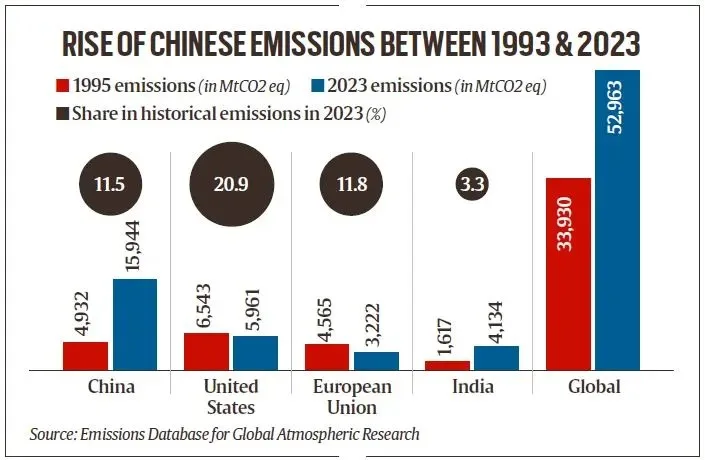Syllabus: GS3/Environmental Pollution & Degradation; Conservation
Context
- China, the world’s largest emitter of greenhouse gases for more than 15 years, faces a significant paradox in its efforts to balance economic growth with environmental sustainability.
China Emissions Paradox: Economic Growth vs. Emission Reductions
- China’s economic growth over the past few decades has come at a significant environmental cost. The country’s heavy reliance on coal for energy has made it the largest emitter of carbon dioxide (CO2) globally, accounting for nearly 30% of annual global emissions.
- Despite this, China has set ambitious targets to peak its carbon emissions by 2030 and achieve carbon neutrality by 2060.

Challenges in Reducing Emissions
- Dependence on Coal: Its heavy dependence on coal for energy and industry requires a massive shift to renewable energy, demanding substantial investment
- In 2023, emissions rose by 5%, largely due to coal-fired plants and steel factories.
- Economic Pressures: As a developing country, China struggles to balance economic growth with environmental sustainability, as rapid industrialization and urbanization increase energy demand.
- Technological and Financial Constraints: Additionally, the technological and financial resources needed to transition its energy infrastructure present significant obstacles.
Global Implications
- The global climate targets, including the 1.5-degree Celsius goal set by the Paris Agreement, hinge significantly on China’s ability to reduce its emissions.
- According to a recent analysis by Carbon Action Tracker, China must reduce its emissions by at least 66% from current levels by 2030 to stay on track with the 1.5-degree Celsius objective.
- It is an extremely challenging target, given the current trajectory of China’s emissions.
Possible Impact of China’s Cutting Down Its Emissions
- Economically, cutting emissions may slow down manufacturing, disrupting global supply chains.
- The energy transition from coal to renewables is complex and costly, potentially leading to energy shortages or price hikes.
- Reducing manufacturing in China could shift production to countries with less stringent regulations, increasing global emissions.
- Geopolitically, China’s emission cuts might strain international relations, particularly with countries reliant on Chinese exports.
Scenario and Challenges in India
- The “Global Carbon Project” has projected that fossil fuel emissions will rise by 4.6% in India and 0.2% in China in 2024, despite global efforts to reduce them.
- India, the world’s third-largest emitter of greenhouse gases, faces a unique set of challenges in addressing climate change, which the global strategy often overlooks.
- While the focus of global climate action is on reducing carbon emissions through renewable energy, India’s socio-economic, geographical, and developmental context makes this approach difficult.
- Despite its large population and growing energy demand, India’s per capita emissions are much lower than those of developed countries.
Conclusion and Balancing Act
- China’s climate actions are marked by a paradox: while it remains a major polluter due to coal use, it is also leading in green technology, reflecting the challenge of balancing economic growth with environmental sustainability.
- China’s dual approach highlights the complexities of its emission reduction efforts, which have significant economic, social, and geopolitical implications. To address these challenges, the global community must collaborate on a balanced, sustainable transition.
- Similarly, India needs a climate strategy that aligns with its development goals, promotes clean energy solutions, and advocates for equitable global policies that hold developed nations accountable.
Previous article
India-Italy Joint Strategic Action Plan 2025-29
Next article
Polio Eradication in India